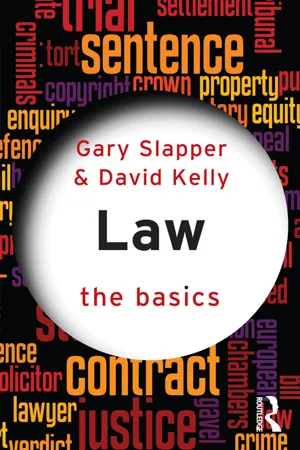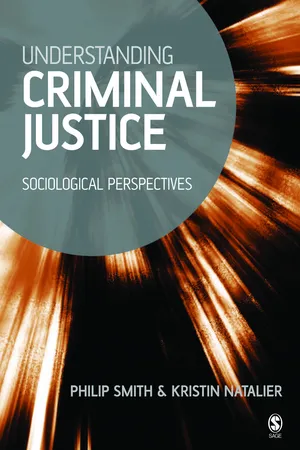Law
Types of Law
Types of law refer to the various categories of legal principles and regulations that govern different aspects of society. Common types include criminal law, which deals with offenses against the state or public, and civil law, which addresses disputes between individuals or organizations. Other types include administrative law, constitutional law, and international law, each focusing on specific areas of governance and regulation.
Written by Perlego with AI-assistance
Related key terms
6 Key excerpts on "Types of Law"
- eBook - ePub
- Gary Slapper, David Kelly(Authors)
- 2012(Publication Date)
- Routledge(Publisher)
Types of LawThere are many ways to divide law into different types. Putting law into categories is like putting people into categories – it can be done in different ways and for different purposes. If you take 100 random people in a crowd you could sort them into groups according to height, or weight, or age, or occupation, or skin colour, or blood type, or place of birth, or any number of other criteria. A 34-year-old, 5 ft 7 in., dark-haired female musician, weighing 8 stone, and born in Hong Kong with blood type O, would be placed among different subsets of people from the 100 depending on how people were being categorised.In the same way, law can be put into different groups according to different criteria. The quantity of law that applies in the UK today is very considerable. It is contained in thousands of voluminous law reports of decided cases judged over many centuries, statutes and regulations passed by Parliament, and a gigantic quantity of European law and European human rights law.Taking this law as a whole, it can be divided according to whether it has originated from judicial pronouncement (judge-made law) or legislation (from Parliament). Equally, it could be divided according to whether it is private law (law, like contract law, which applies to people in the private relations they might have as citizens or organisations) or public law (like criminal law which applies to everyone at large).Very commonly, a single transaction or relationship or event will entail the relevance of a great many laws and several Types of Law. For example, consider the awful case of a lorry travelling at speed along a motorway, crashing into a car that had stopped on the hard shoulder, killing one of a number of people standing near the car, and then smashing through the barrier and plunging down an embankment on to a railway line in front of an oncoming train. All sorts of law could be applied to such a dreadful situation including the following: - eBook - ePub
Cybercrime and Information Technology
Theory and Practice: The Computer Network Infostructure and Computer Security, Cybersecurity Laws, Internet of Things (IoT), and Mobile Devices
- Alex Alexandrou(Author)
- 2021(Publication Date)
- CRC Press(Publisher)
If a defendant considers the verdict unfair, the case may be appealed, and it is sent to the appropriate Appellate court, usually called the Appeals court. This court hears and reviews legal cases that have already been heard in a lower court. In Appellate court, the lawyers argue before a judge or a panel of judges, focusing on legal and policy principles.Each State in the United States plus the District of Columbia has at least one Supreme Court. Oklahoma and Texas each have two Supreme Courts, one for civil and one for criminal appeals. While the State Supreme Courts hear appeals on legal issues from lower state courts, the U.S. federal courts may overrule a state Supreme Court decision if it is a ruling on a question of federal law.3.3 Types of Laws
Major areas of the law include Bankruptcy, Business or Corporate, Civil Rights, Cyber, Entertainment, Environmental Law, Family, Health, Intellectual Property, International, Labor or Employment Law, Maritime, Real Estate, and Tax Law.The three Types of Law that concern cybercriminals are Administrative, Civil, and Criminal laws. These laws are administered during legal proceedings.A legal proceeding is a procedure or legal action in a court of law or arbitration panel instituted in order to enforce the law. In a proceeding, the participants present evidence based on an argument that supports their claims on how to interpret the law.3.3.1 Administrative Law
Earlier in the chapter we defined Administrative law as powers, or regulations created and enforced by administrative agencies of federal, state, and local levels of government. Administrative law is also comprised of less binding guidance that is supposed to help industry participants understand and implement the governing regulations.The U.S. Constitution refers to the three branches of government as: Legislative, Executive, and Judicial according to “U.S. Const. art. I”, “U.S. Const. art. II”, and “U.S. Const. art. III”. Administrative agencies are not referred to in the U.S. Constitution, but unofficially, have been called the fourth branch of government. They are officially part of the Executive branch, which is why their department heads are appointed by the President. - eBook - ePub
Law and Society
An Introduction
- Steven Barkan(Author)
- 2023(Publication Date)
- Routledge(Publisher)
5Types of LawDOI: 10.4324/9781003288480-5Learning Objectives
- Identify the elements of a crime.
- Describe the major legal defenses to criminal responsibility.
- List the types of executive orders.
- Explain the difference between substantive law and procedural law.
- Summarize criticisms of military law and military justice.
Many Types of Law exist in the United States and other modern nations. We review the major types in the United States and devote much of our attention to the criminal law, the most familiar and interesting type to many Americans but also one that is very complex and the source of much controversy and debate.Criminal Law
Criminal law - eBook - ePub
- Tom Craig, David Campbell(Authors)
- 2012(Publication Date)
- Routledge(Publisher)
The Legal Environment
DOI: 10.4324/9780080454603-14Learning Objectives
After studying this chapter, students should be able to describe:- the nature of law and legal rules;
- the nature of and difference between civil law and criminal law;
- the nature of and difference between common law and statute law;
- the purpose and structure of the British and European Union(EU) judiciaries;
- the types of EU law and the EU legislative process;
- the key areas of business law and the relevant legislation.
14.1 What is Law?
When we consider how legal matters affect businesses and other organisations, we should consider it to be essentially a part of the political environment. However, its complexities and importance necessitate a more detailed discussion. This is the objective of this chapter.Definition and Purpose of Law
A System of Rules
In any society, the complex interrelationships between legally responsible parties, such as people and companies, need to be regulated. It is generally understood that limits must be placed upon activities to prevent miscreants and other irresponsible people from abusing their freedom in a democratic state. Such acceptation leads to the enforcement of ‘rules’. However, not all rules carry the same weight. A distinction needs to be drawn between legal rules and other types of rules. We sometimes use the term ‘rules’ to describe norms of behaviour in society. We may consider ourselves to be breaking ‘social rules’ if we act in an antisocial manner, such as dressing in an unconventional way, or if we are rude or insulting to others. Within organisations, rules are imposed to facilitate normal functioning and may take the form of rigid procedures and limits of behaviour, such as a rule that receipts must be provided to support all expense claims.Legal rules are different from social and other rules. They are characterised by the fact that they are enforceable by the judiciary which acts on behalf of the state. So whereas the de facto - eBook - ePub
Understanding Criminal Justice
Sociological Perspectives
- Philip Smith, Kristin Natalier(Authors)
- 2004(Publication Date)
- SAGE Publications Ltd(Publisher)
civil law system in which laws are systematically codified into a more coherent whole than is found in common law. However, there is less judicial discretion in the construction and interpretation of law. Civil law is more directly linked to Roman law and canon (church) law, both of which were listed and organized by jurists. The system more obviously reflects the rationalizing of the law with the state legislating its meaning.Court systems vary according to country and jurisdictions within countries. The following provides a very brief discussion of how courts are generally ordered. Courts are hierarchical. In their original jurisdiction, higher courts address more ‘serious’ crimes, often those with harsher penalties. They also have an appellate function. This means that parties can appeal to have the decisions reached in the lower courts reviewed, altered or overturned. This only occurs in limited circumstances, and appeals are based on a matter of law, not a question of fact. The division of labour is also affected by different jurisdictions. These may be geographical, in that crimes committed in one area are tried by the court associated with that place. Courts also hear different types of offences. In the USA and Australia, some offences are defined by Federal law, and others are created through state legislation. The courts have general jurisdiction, in that they hear a range of offences. Other courts are responsible for hearing only very specific issues. Juvenile courts are perhaps the most obvious example in the criminal justice system. They hear cases involving perpetrators under a certain age on the basis that young people are impressionable and vulnerable and in need of protection and reformation (Wundersitz, 2000: 103). In more recent times, law and order advocates have argued for a return of particular categories of young offenders into the mainstream court system, to be dealt with as adults. Military tribunals, drug courts, boards and appeals tribunals are other examples of forums that hear particular types of crime. - eBook - ePub
- Carole Fleming, Emma Hemmingway, Gillian Moore, Dave Welford(Authors)
- 2005(Publication Date)
- SAGE Publications Ltd(Publisher)
Students of journalism and those in the profession need to have a sound and up-to-date understanding of the legal system within which they operate. A familiarity with the legal institutions and processes that regulate social activity and inform current political, economic and sociological debates is crucial to the intelligent reporting of news events and in fulfilling the media’s role as a vital source of information and defender of public interests. This chapter seeks to identify key legal systems and principles and in particular to raise an awareness of the day-to-day significance of law to the world of journalism. An overview of the substantive legal provisions which affect the work of journalists is considered in the following chapter.In this chapter the various sources and divisions of English law are described. The reader is introduced to the composition and jurisdiction of the current system of courts and tribunals and a quick reference guide is given to key legal personnel. A ‘Glossary of Legal Terms’ is also provided at the end of the book.The English legal system includes the law as applicable to England and Wales. A different legal system applies in Scotland and journalists working in an international dimension should be aware of the need to check local rules and regulations.DIVISIONS OF LAW
There are a number of ways in which the law can be categorised. This mechanism enables the user to compare, contrast, distinguish and comment upon aspects of the English legal system. These divisions of law do overlap and their meaning is dependent upon the context in which they are used.COMMON LAW AND CIVIL LAWIn this context, the term ‘common law’ is used to define the development of legal principles through the judicial interpretation of statutes and judge-made case law as a contrast to the Continental system of civil law.COMMON LAW AND STATUTE LAWCommon law is the body of law derived from custom or judicial precedents where no statutory provisions are to be found. Statute law is the body of law created by Parliament. A legal rule may exist in common law and then be changed through the introduction of a statute that the courts must then take to be the source of that law.PUBLIC LAW AND PRIVATE LAWPublic law is concerned with the legal relationship between the state and the individual and the exercise of power by the state. Criminal law is an example of public law, although some areas of civil law also fall into this category. Private law, in contrast, covers the legal relationship between individuals.
Learn about this page
Index pages curate the most relevant extracts from our library of academic textbooks. They’ve been created using an in-house natural language model (NLM), each adding context and meaning to key research topics.





